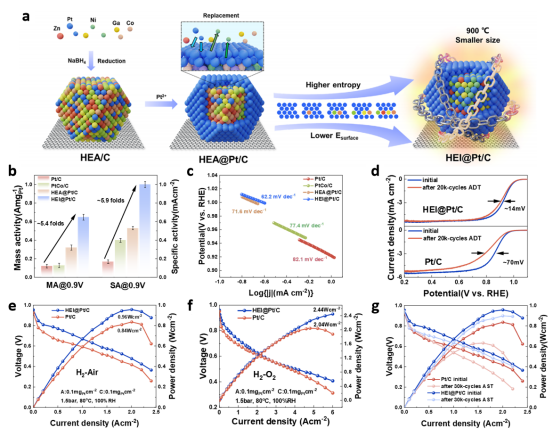Research Progress
High-loaded Pt intermetallic compounds (IMCs) present the practical application potential in low-Pt PEM fuel cells while ordering transformation under high temperature inevitably leads to severe sintering of high-density IMC nanoparticles (NPs), thus the decayed oxygen reduction reaction (ORR) performance.
Motivated by such a challenge, a research team led by Prof. YANG Hui at Shanghai Advanced Research Institute (SARI) of the Chinese Academy of Sciences proposed an entropy-increase assisted anti-sintering concept to fundamentally reduce the surface energy of NPs by increasing the mixing entropy, thus hindering the migration and coalescence of NPs.
The research results were published in Advanced Functional Materials in May, 2025.
Ex/in situ electron microscopy and density functional theory (DFT) corroborate that the higher the entropy of pristine NPs, the lower the surface energy, the smaller the average size, and the more uniform distribution after annealing.
The prepared Pt high-entropy IMC (Pt-HEI@Pt/C) demonstrates high metal loading (40.53 wt.%) and small particle size (≈3.15 nm). The reinforced strain regulation effect of the HEI core on the Pt shell, which optimizes the *OOH adsorption and elevates the energy barrier of Pt dissolution, thus simultaneously enhancing the intrinsic ORR activity and durability.
The prepared Pt-HEI@Pt/C catalysts exhibited an excellent ORR activity with mass activity (MA@0.9V, 0.65 A mg−1 Pt) and durability over 20k potential-cycling.Membrane electrode assembly integrated with this catalyst delivers a peak power density of 0.96 W cm−2 and an exceptional stability (12.5% decline in MA) under H2-air condition at 0.1 mgPt cm−2.
This study not only offers a new concept to fundamentally inhibit the NPs sintering under high temperature but also provides an ideal approach to synthesize high-loaded and small-sized Pt-IMCs/C catalysts toward the ORR, laying the foundation for the future development of low-Pt fuel cells.

Electrocatalytic performance of the prepared Pt-HEI@Pt/C catalysts (Image by SARI)





